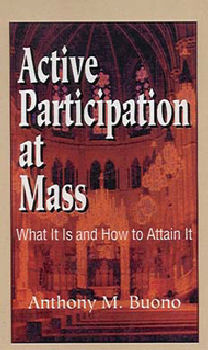
|
Posted March 16, 2006
Book: Active Participation At Mass: What it is and how to attain it Author: Anthony M. Buono Alba House, New York, 1994, pp. 143 An Excerpt from the Jacket:
An Excerpt from the Book: Real Meaning Purpose of the Gospel Procession One of the many benefits of the Gospel Procession is that it helps to impart the real meaning and purpose of the Gospel proclamation at Mass. The Gospel reading (like all the readings) is not just an exercise in imparting information about God and his dealings with human beings. Neither is it a simple instruction on the teachings of the faith. The Gospel proclamation is an event, a happening. It is an intervention here and now on the part of God the Father — in the life of this community gathered to celebrate the Eucharist. It is the continuation of the History of Salvation today. Not only has God intervened in the Old Testament through his patriarchs and prophets. Not only has he intervened in the New Testament through his only-begotten Son. He now intervenes in the lives of people today – mainly through the liturgical rites of the Church, which render Christ present in his Mysteries through the Holy Spirit. In this communication, the Gospel has a privileged place, as shown by the unique liturgical features that surround it. The Gospel is the only reading preceded by a procession, by an acclamation, by a blessing, and by a prayer. The Gospel is reserved for a person in Holy Orders whereas the other readings can be proclaimed by lay people. It is honored by lighted candles and incense and preceded by a call for attention: “The Lord be with you.” Then we all make the Sign of the Cross on our forehead, lips, and heart — that is, we consecrate with the sign of our redemption our thoughts, words, and sentiments. At the end, the one who proclaims the Gospel kisses the Book as an act of loving homage addressed to Christ himself. The people of the assembly respond to the introduction to the Gospel reading with the words: “Glory to you, Lord,” and at the end they utter one more acclamation: “Praise to you, Lord Jesus Christ” – both are addressed to Christ who by this action has come among us! While the Gospel Procession takes place, an acclamation is sung — in honor of the Christ who comes to “evangelize” his people. He has already spoken in the other readings (“He himself speaks when the Holy Scriptures are read in the Church.” Now he will speak to his people in a way that is much clearer, more personal, more decisive, and more enriching than in the previous texts proclaimed. The Acclamation comprises a short biblical sentence, praising God in his function of Teacher (Master) and preacher. It may also recall a scriptural thought proper to the feast or the day. By entering into the spirit of this Gospel Procession, the people in the assembly become conscious of Christ’s personal presence among them as surely as he walked among the people in Palestine two thousand years ago. He comes in his Word to proclaim his message anew – only this time it is to us,to our specific assembly and community so that he may direct that message and that Word to our particular problems, states, and desires. The Gospel Procession puts us in the ideal mood to open our hearts to Christ and to his Word! Table of Contents: 1. Recognizing Sacramental World 2. Understanding what participation is 3. Carrying out the people’s parts 4. Utilizing ways to better participation 5. Entering into the five amens 6. Encountering Christin the Word of God 7. Praying the responsorial psalm 8. Appreciating the Gospel Procession 9. Professing the faith 10. Participating in the Eucharistic Prayer 11. Partaking of the Lord’s banquet 12. Living the liturgical year |
|
